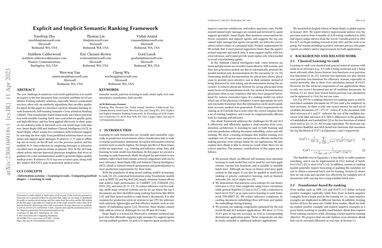Explicit and Implicit Semantic Ranking Framework
The core challenge in numerous real-world applications is to match an inquiry to the best document from a mutable and finite set of candidates. Existing industry solutions, especially latency-constrained services, often rely on similarity algorithms that sacrifice quality for speed. In this paper we introduce a generic semantic learning-to-rank framework, Self-training Semantic Cross-attention Ranking (sRank). This transformer-based framework uses linear pairwise loss with mutable training batch sizes and achieves quality gains and high efficiency, and has been applied effectively to show gains on two industry tasks at Microsoft over real-world large-scale data sets: Smart Reply (SR) and Ambient Clinical Intelligence (ACI). In Smart Reply, $sRank$ assists live customers with technical support by selecting the best reply from predefined solutions based on consumer and support agent messages. It achieves 11.7% gain in offline top-one accuracy on the SR task over the previous system, and has enabled 38.7% time reduction in composing messages in telemetry recorded since its general release in January 2021. In the ACI task, sRank selects relevant historical physician templates that serve as guidance for a text summarization model to generate higher quality medical notes. It achieves 35.5% top-one accuracy gain, along with 46% relative ROUGE-L gain in generated medical notes.
PDF Abstract

